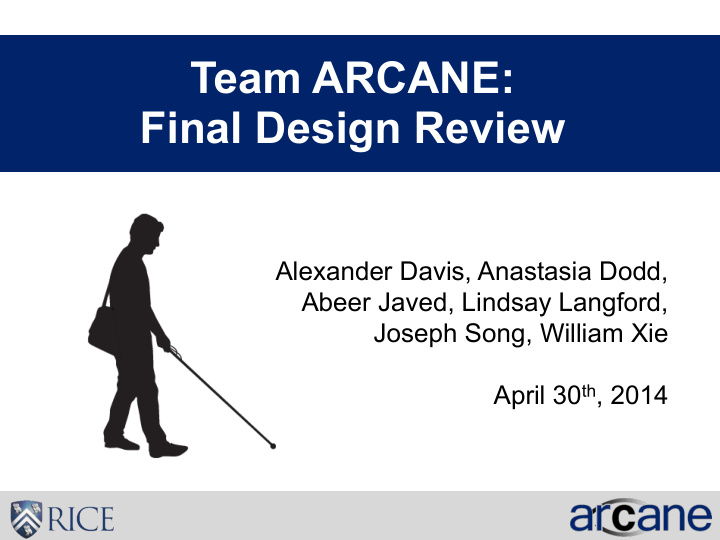



Team ARCANE: Final Design Review Alexander Davis, Anastasia Dodd, Abeer Javed, Lindsay Langford, Joseph Song, William Xie A Navigation Aid for the Visually Impaired April 30 th , 2014
Mission Statement “ Team ARCANE aims to create a supplement to the white cane that would warn visually impaired of upcoming obstacles that they might not identify otherwise. ”
Objectives A. Conceptual & Planning
Design Camera Mount A1 ▪ Designed a compact enclosure for the cameras ▪ Required second iteration due to time constraint ▪ Front holes for lenses ▪ Back holes for wiring The camera mount was successfully created through a CAD model.
Design Haptic Hardware A2 ▪ Integrated PCB includes Propeller, motor driver, serial over USB and Bluetooth ▪ Board has headers to connect compass and battery charger PCBs The design for the PCB has been successfully created.
Objectives B. Implementation
Port Depth Map to Intel Board B1 ▪ OpenCV optimized for Intel • Uses Intel Integrated Performance Primitives library (e.g. SSE) ▪ Intel NUC D54250WYK • Intel i5 4250U • 2 cores, 1.3 – 2.6 GHz • Wifi + Bluetooth card Installed Ubuntu 12.04LTS and achieved a frame rate of over 8 fps.
Speed Up Block Matching B2 ▪ Changed hardware ▪ Tweaked block size , number of search paths , & image resolution ▪ Removed multi-threading Demonstration The Semi-Global Block Matching calculation has been sped up such that we can generate a depth map at over 8 fps.
Accurate Distance Estimation B3 Distance Calibration ▪ Exponential fit 400 y = 18.619e 0.0328x Expected Distance (cm) R ² = 0.9786 ▪ Set minimum & 300 maximum values 200 ▪ Average percent error of 7.35% 100 0 0 23 45 68 90 Calculated Distance (cm) The depth map outputs distance data with an error margin of 7.35% of the true distance of the object.
Build Camera Mount B4 ▪ Enclosure laser cut and assembled from acrylic • Weather-sealed ▪ Mount attaches onto a flat bill hat with Velcro • Does not affect structure of hat • Brim does not bounce as user walks around A sealed weather-proof camera mount has been created that attaches to the top of any hat.
Integrate Haptic Software B5 ▪ Allow compass and sensors to set motor intensity concurrently • Parallel code • Mutex protected • 7-way (!) parallel The haptic feedback and compass software run successfully at the same time.
Build & Test Subsystem Hardware B6 ▪ Successfully built and tested integrated PCB ▪ Bluetooth module is prone to ESD , but nothing else has needed to be replaced Demonstration The components on the integrated PCB work as well as they did separately.
Bluetooth Communication B7 ▪ Haptic and sensor subsystems can communicate over Bluetooth ▪ RN42 on haptic side interfaces with Propeller like a serial port Demonstration The haptics and sensors subsystems can successfully communicate through Bluetooth
Design & Build Power System B8 ▪ Haptic system: LiFePO4 charger and pack • Uses TI bq24630 charger IC • ~8hr battery life expected ➢ 7.2Wh battery, .88W avg. load ▪ Sensors: LiFePO4 19.2V 63.4Wh battery • ~5hr battery life The system is projected to have a battery life of ~5 hours with its chargers.
Wearable Final Prototype B9 One-size-fits-all cap for sensor Backpack for Intel NUC & battery Bicep attachment for PCB case Adjustable Velcro arm sleeve for vibration motors The final prototype can be worn correctly by the user with assistance in ~2 minutes .
Objectives C. Testing & Verification
Sensor Placement & Depth Map C1 White Cane: Head: ▪ Waved from side to side ▪ Head serves as natural damper ▪ Average of 1.28 swing / ▪ Controlled by user second
Sensor Placement & Depth Map C1 White Cane: Head: Placing the sensor on the head allows for more stable image quality, successfully generating a depth map for the haptic subsystem.
Test on Visually Impaired C2 ▪ Conducted tests on seven % Accuracy Map of blind-folded individuals: Vibration Layout • 2 minutes of training 93% 83% • Vibrated individual motors (26/28) (25/30) • User identified location ▪ 78% success rate of 86% 57% identifying object location (25/29) (16/28) ▪ Users gained confidence and accuracy over time 66% 79% (19/29) (23/29)
Test on Visually Impaired C2 ▪ Met with two visually impaired individuals ▪ Feedback on the ARCANE: • Hard to localize vibrations • Suggested pulses over constant vibrations • Design needs to be slimmed down • Enjoyed that it didn’t interfere with daily tasks While we did have successful preliminary results with blind-folded individuals, visually impaired individuals provided us with constructive feedback crucial for any future work on this project.
Build Final Prototype C3 Final integrated system features: ▪ Accurate stereovision sensor on cap ▪ Vibratory feedback to the arm ▪ Serial communication between the two ▪ Simple turn on procedure ▪ Easy to put on, wearable design Demonstration Team ARCANE has successfully created a fully functional final design.
Acknowledgements ▪ Fox Family ▪ Dr. Gary Woods ▪ Dr. Marcia O’Malley ▪ Prof. Gene Frantz This project was sponsored by the Fox Family. The design work for this project was supported by the resources of the Oshman Engineering Design Kitchen.
Recommend
More recommend